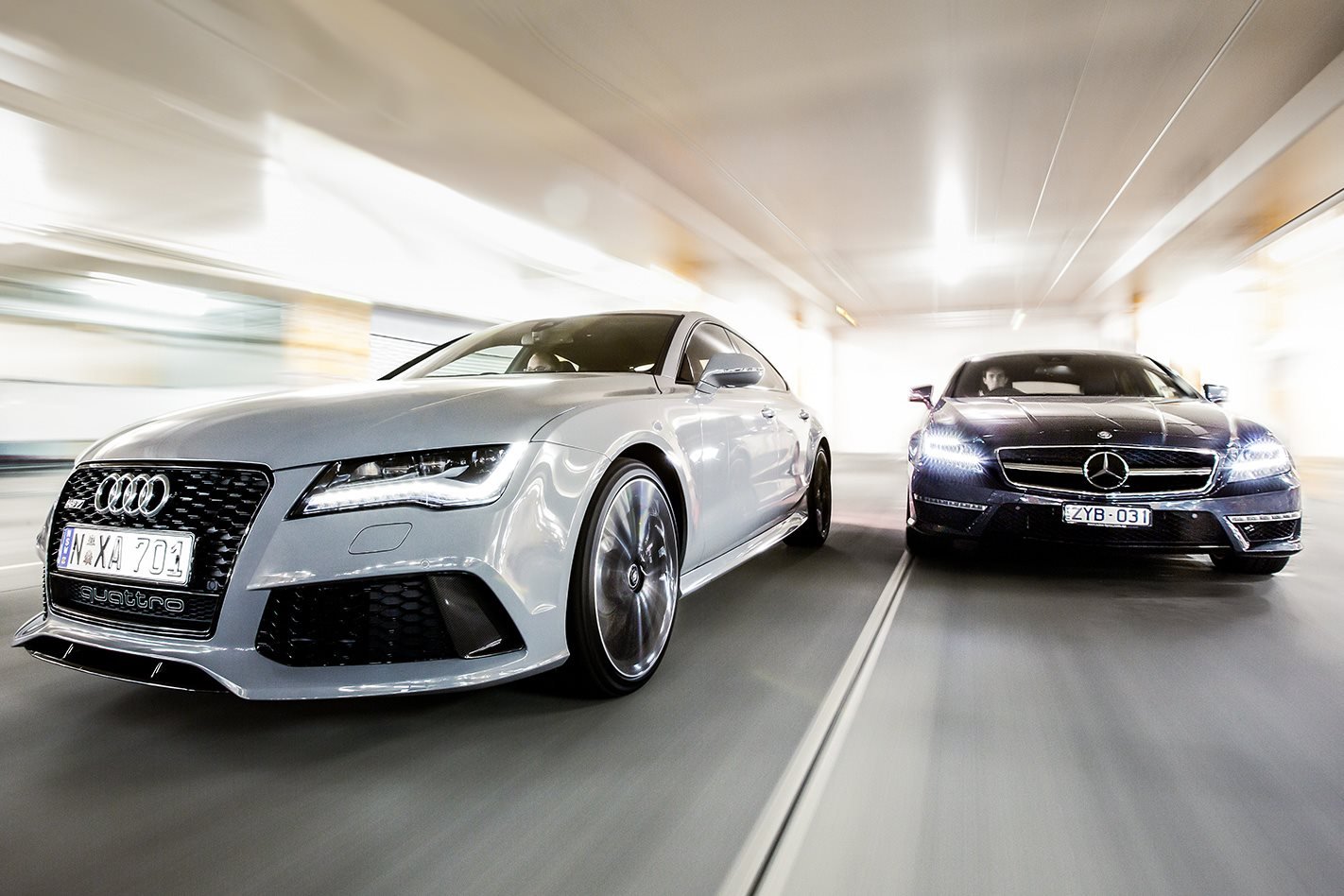Let’s play a quick game of word association: muscle.
If your mind doesn’t immediately conjure an image of a bellowing American (or Australian) V8s and tortured rear tyres, then maybe these German takes on a classic theme are more for you.
In the love-it-or-hate-it Nardo Grey corner, we have the latest Audi RS7 Sportback. In the Tenorite Grey (metallic) corner, it’s the two-breath special from Affalterbach, the Mercedes-Benz CLS63 AMG ‘S’ Shooting Brake.
Both are vehicular niches in design, the RS7 based on the A7 four-door ‘coupe’ which was created to compete with the regular CLS and BMW’s 6 Series Gran Coupe. As if to go one better, Mercedes decided to throw a roofline extension and tailgate onto its already distinctive CLS to create a wagon, adopting the more romantic ‘Shooting Brake’ nomenclature to suit its rarefied status. And rarefied it is, the tested example coming to $265,145.
On paper, this may seem a tad expensive when looking at the $238,500 Audi asks for an RS7. But incredibly, a handful of options boosts the tested Sportback to $277,800 – significantly more than the AMG.

It’s that last package which holds the most interest, as it replaces the standard-fit ‘air’ suspension with steel springs, adds ‘dynamic ride control’ variable damping, dynamic steering, and an upgraded limiter which allows for a 280km/h top end.
The 1995kg RS7 is powered by the same 4.0-litre twin-turbocharged V8 found in the RS6, with its turbochargers and exhaust system located within the ‘Vee’. The turbos can boost to 1.2-bar, helping the engine achieve a 412kW power peak from 5700-6600rpm. This is backed by 700Nm of torque, spread thick and even from 1750rpm all the way to 5500rpm.
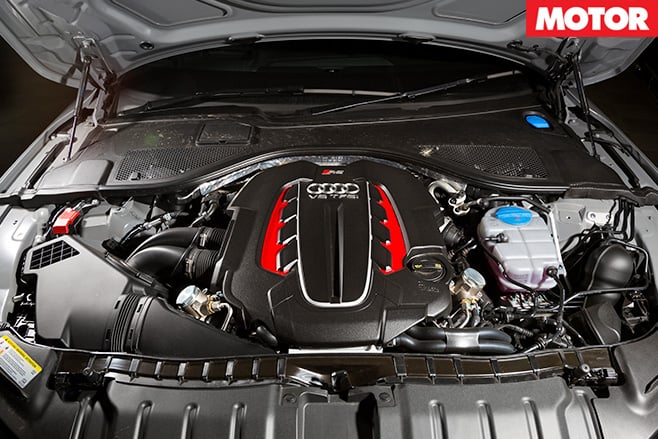
Mammoth 21-inch cast aluminium wheels are wrapped in 275/30ZR21 rubber (Continental SportContacts on this example) and braking is taken care of by funky lightweight ‘wave design’ internally vented discs. They measure 390mm at the front and are clamped by six-piston calipers. Ceramic brakes are optional for $20,940.

Displacing 5.5 litres and also twin-turbocharged, the eight-pot Merc produces peak outputs of 430kW at 5500rpm and 800Nm from 1750-5000rpm. The ageing seven-speed
AMG Speedshift MCT, an auto transmission that uses a ‘wet’ multi-plate clutch and does without a torque converter, is employed, and can be shifted – like the Audi – via paddles behind the steering wheel.

The CLS63 S retains an interior of appreciable quality, though its layout and busy centre stack age it against the clean modernity of the RS7. Nevertheless, the AMG drips fine breeding, from its leather-topped dash and infinitely adjustable heated and cooled Nappa leather seats to its alcantara-trimmed steering wheel and superbly tactile alloy shift paddles.
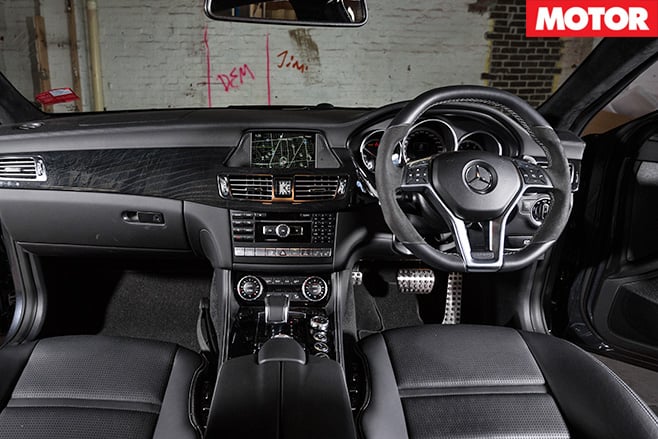
The Audi’s 8.0-inch multimedia touchscreen is also an inch larger and easier to navigate. But that’s enough spec-sheeting. Let’s fire these animals up.
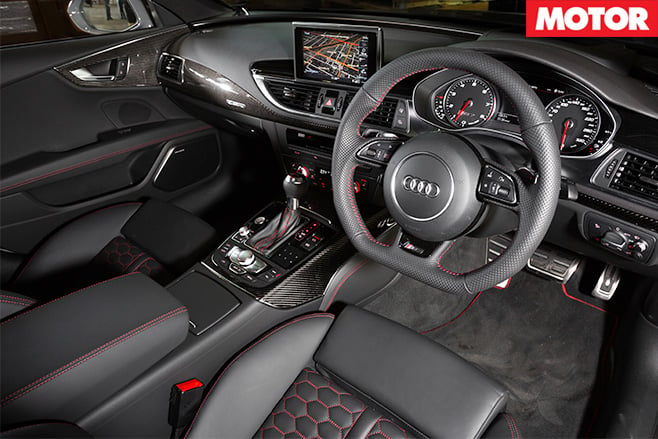
The ageing gearbox feels like a dual-clutch in this regard, converting throttle position into forward motion with a delay not present when a torque converter – like in the Audi – is equipped. Selecting sport (or engaging first gear manually) reduces this ‘lag’ and reveals the mighty biturbo V8’s potency more readily.
The 1955kg Benz can make rapid progress without ever awakening the turbochargers, all to the accompaniment of a restrained V8 backbeat. Find an opportunity to stretch your right foot, however, and there’s a momentary pulse of anticipation before the full force of 1.0-bar boost is felt. At this point the sophisticated German turns decidedly old-school, squatting on its arse as it delivers an 800Nm kidney punch to the cabin’s occupants.
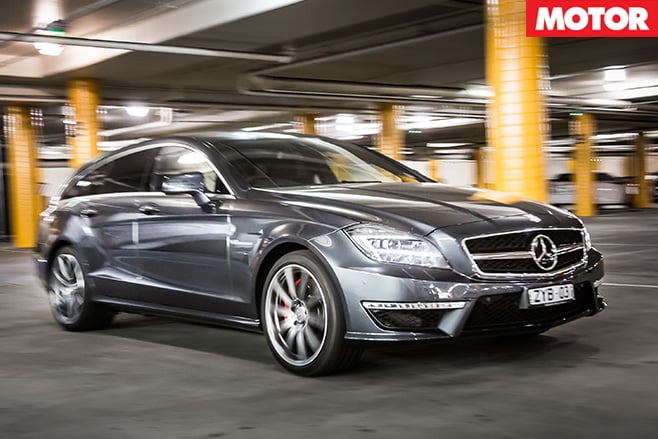
Punching out to the redline in manual mode, the CLS63 builds speed so quickly you have to request an upshift at around 6000rpm, lest the engine head-butt the 6500rpm limiter before the change arrives. It’s an altogether intense experience.
Despite giving away 100Nm at its peak, the RS7’s acceleration is just as vivid, albeit deployed in a completely different way. The Audi’s combination of quattro grip, near lag-free power delivery and a more intuitive gearbox means the RS7 can live by the classic Aussie mantra: get in, sit down, shut up and hang on. If you can live with the accelerative G, you can achieve blisteringly consistent full-throttle runs in this car, though the sound being piped through to the cabin sounds oddly artificial.
Along these lines, the Audi’s widely variable drive mode settings also feel contrived, though it has come a long way from the similar system employed in earlier RS models. That being said, there is not one mode which offers the right mix of control and response on Australian roads.
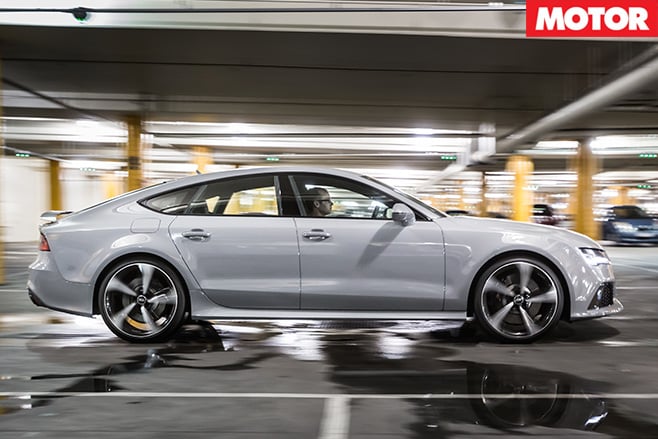
Complementing the Audi’s incredibly linear power delivery is its ample traction, which allows you to pin the throttle hard and early, the quattro system perceptibly shifting drive to the corners that can dig in the hardest at any given time. It’s a pity when the next corner arrives, braking isn’t as impressive. The RS7 has a firm, unresponsive brake pedal that requires a firm shove for real retardation, making it difficult to nuance your corner entry speed.
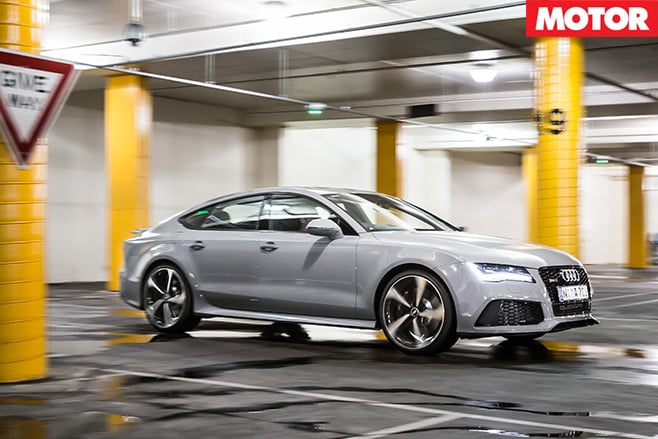
Given the Audi’s ability to devour such roads, the even more powerful, rear-drive AMG should have its work cut out to keep up, but in practice the brakes performs admirably.
Even in its hardest damper setting, the AMG has a more resolved ride than the comfort mode in the RS7. It enables you to focus on the driving line rather than potentially unsettling surface bumps. What’s more, when driven with throttle sensitivity, the Merc finds a level of traction which leaves something like a BMW M6 gasping in exhaust gas.

In essence, both these vehicles have taken the muscle car theme and lifted it to an incredibly sophisticated level. That the AMG has achieved this while retaining more of the genre’s traditional roots has to be applauded, but it’s the more complete, modern Audi that takes the gong. It’s a bona fide V8 muscle car for the 21st century – just keep an eye on those option boxes.
| u00a0 | u00a0 | Audi RS7 | u00a0 | Merc CLS63 S AMG |
| u00a0 | u00a0 | 4 out of 5 stars | u00a0 | 4 out of 5 stars |
| Body | u00a0 | 4-door, 5-seat sportback | u00a0 | 4-door, 5-seat wagon |
| Drive | u00a0 | all-wheel | u00a0 | rear-wheel |
| Engine | u00a0 | 3993cc, V8, DOHC, 32v, twin-turbo | u00a0 | 5461cc, V8, DOHC, 32v, twin-turbo |
| Bore/Stroke | u00a0 | 84.5 x 89.0mm | u00a0 | 98.0 x 90.5mm |
| Compression | u00a0 | 10.1:1 | u00a0 | 10.1:1 |
| Power | u00a0 | 413kW @ 5700-6600rpmu00a0 | u00a0 | 43OkW @ 5500rpm |
| Torque | u00a0 | 700Nm @ 1750-5500rpm | u00a0 | 800Nm @ 1750-5000rpm |
| Power/weight | u00a0 | 207kW/tonne | u00a0 | 220kW/tonne |
| Consumption | u00a0 | 9.8L/100km (claimed) | u00a0 | 10.6L/100km (claimed) |
| CO2 Emissions | u00a0 | 229g/km (claimed) | u00a0 | 248g/km (claimed) |
| Transmission | u00a0 | 8-speed auto | u00a0 | 7-speed auto |
| Weight | u00a0 | 1995kg | u00a0 | 1955kg |
| Suspension | u00a0 | multi-links, coil springs, anti-roll bar (f/r)u00a0 | u00a0 | A-arms, coil springs, adaptive dampers, anti-roll bar (f); multi-links, air springs, adaptive dampers, anti-roll bar (r) |
| L/W/H | u00a0 | 5012/1911/1419mm | u00a0 | 5000/1881/1436mm |
| Wheelbase | u00a0 | 2915mm | u00a0 | 2874mm |
| Tracks | u00a0 | 1634/1625mm (f/r) | u00a0 | 159 6/1626mm (f/r) |
| Steering | u00a0 | electrically-assisted rack and pinion | u00a0 | electrically-assisted rack and pinion |
| Brakes | u00a0 | 390mm ventilated discs, 6-piston calipers (f); 356mm ventilated discs, single-piston calipers (r)u00a0 | u00a0 | 360mm ventilated discs, 6-piston calipers (f); 360mm ventilated discs, 4-piston calipers (r) |
| Wheels | u00a0 | 21 x 9.0-inch (f/r) | u00a0 | 19 x 9.0-inch (f); 19 x 10.0-inch (rear) |
| Tyres | u00a0 | 275/30 ZR21 (f/r) Continental SportContacts | u00a0 | u00a0255/35 R19 (f); 285/30 R19 (r) u00a0Pirelli P Zeros |
| Price | u00a0 | u00a0$238,500 | u00a0 | $265,145 |
| Price as tested | u00a0 | $277,800* *Carbon Styling Package ($8500); Exclusive Design Package ($13,900); Bang & Olufsen sound System ($12,000); Dynamic Package ($4900) | u00a0 | $265,145 |
| Positives | u00a0 | Mind-numbingly fast; incredible traction; feels super expensive | u00a0 | Brilliant chassis balance; great ride; sledgehammer engine punch |
| Negatives | u00a0 | Pricey with options; Drive Select fails to convince; brakes a bit numb | u00a0 | Slow-witted gearbox; looks strange from some angles |

